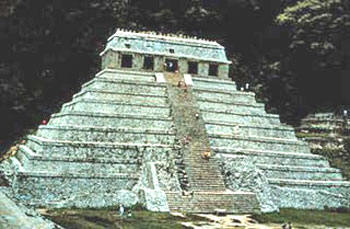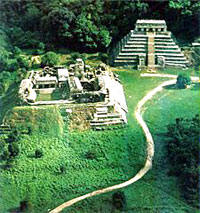|
Dominating the scene of Palenque is the Temple of the Inscriptions, the most impressive memorial to a single person in all of ancient America. It was built by the king whose monument it was to become - K'inich Janaab' Pakal ("Pacal the Great").
His body was interred under the temple pyramid in the most grandiose crypt and sarcophagus known outside ancient Egypt.
A cut-away drawing of the front elevation of the structure shows the first building phase at the time of K'inich Janaab' Pakal's reign, with the stairs leading down to the tomb deep beneath the pyramid.
The Temple of the Inscriptions, named for the hieroglyphic texts on the inner walls of the temple, the most extensive surviving Maya inscription, is superimposed upon a truncated pyramid substructure made up of nine receding divisions, each sloping toward the top. Four platforms divide the front stairway into an ascending series of 9, 19, 19, 13 and 9 steps, making a total of 69 stairs to the top. Interestingly, it was in his sixty-ninth year of reign that K'inich Janaab' Pakal died.
A low rectangular temple with a mansard roofcomb (see above image), is set upon the last of the segmented piers sculptured in stucco. The four center piers are free-standing except at the top where they are spanned by wooden lintels. The two end piers each form closed corners at the sides of the building. In ancient times the entire structure, including the roof and roofcomb, and probably the pyramid, was painted a deep dark red, as was the custom throughout the city.
Only the Temple of the Inscriptions of Palenque was built from its inception as a burial chamber. A stairway descends through a series of corbeled vault arches from the temple at the top of the pyramid to the grandiose tomb two meters below the plaza floor upon which the temple was built.
The sarcophagus and its covering slab were sculptured in place first. The pyramid and stairs within it were built from the base up after the crypt was finished. The Temple of the Inscriptions is unique in all Mesoamerica in this respect.
|





